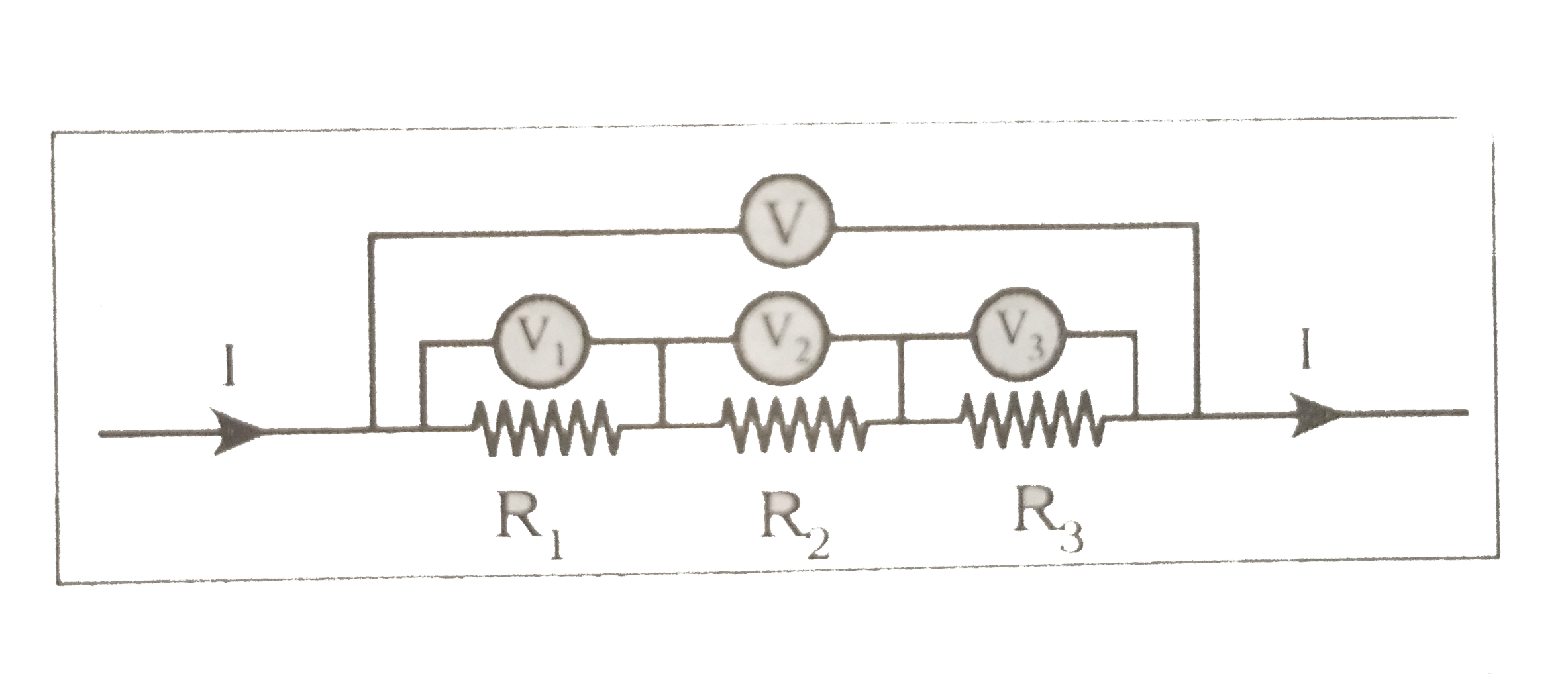Derive R=R1+R2+R3.
Series connection :
In series connection of resistors there is only one path for the flow of current in the circuit. Hence, the current in the circuit is equal to I.
According to Ohm's law,
∴V1=IR:V2=IR2andV3=IR3.
⇒ Let R be the equivalent resistance of the combination of resistors in series.
Also V=IReq
V=V1+V2+V3
IReq=IR1+IR2+IR3
rArrcancel(I)R_(eq)=cancel(I)(R_(1)+R_(2)+R_(3))
⇒Req=R1+R2+R3
∴ The sum of individual resistance is equal to their equivalent resistance when the resistors are connected in series.

Topper's Solved these Questions
- BOOK - VGS PUBLICATION-BRILLIANTCHAPTER - ELECTRIC CURRENTEXERCISE - APPLICATION TO DAILY LIFE, CONCERN TO BIODIVERSITY37videos
ELECTRIC CURRENT
- BOOK - VGS PUBLICATION-BRILLIANTCHAPTER - ELECTRIC CURRENTEXERCISE - FILL IN THE BLANKS8videos
ELECTRIC CURRENT
- BOOK - VGS PUBLICATION-BRILLIANTCHAPTER - ELECTRIC CURRENTEXERCISE - SECTION - IV (4 Marks Questions)16videos
ELECTRIC CURRENT
- BOOK - VGS PUBLICATION-BRILLIANTCHAPTER - CHEMICAL REACTIONS AND EQUATIONSEXERCISE - ESSENTIAL MATERIAL FOR EXAMINATION PURPOSE1videos
CHEMICAL REACTIONS AND EQUATIONS
- BOOK - VGS PUBLICATION-BRILLIANTCHAPTER - ELECTROMAGNETISMEXERCISE - CREATIVE QUESTION FOR NEW MODEL EXAMINATION (SEC-4)30videos
ELECTROMAGNETISM
Similar Questions
If I is the incenter of ΔABCandR1,R2,andR3 are, respectively, the radii of the circumcircle of the triangle IBC, ICA, and IAB, then prove that R1R2R3=2rR2
View SolutionIf I is the incenter of ΔABCandR1,R2,andR3 are, respectively, the radii of the circumcircle of the triangle IBC, ICA, and IAB, then prove that R1R2R3=2rR2
View Solution
Knowledge Check
- Question 1 - Select One
The possible percentage error in computing the parallel resistance R of three resistances R1,R2,R3 from the formula 1R=1R1+1R2+1R3, if R1,R2,R3 are each 1.2% in error, is
A1.2%B2.4%C0.6%D1.8% - Question 2 - Select One or More
Statement I In a ΔABC,ifa<b<c and ri si inradius and r1,r2+r2r3 are the exradii opposite to angle A,B,C respectively, then r<r1<r2<r3.
Statement II For, ΔABCr1r2+r2r3+r3r1=r1r2r3rAStatement I is True, Statement II is True, Statement II is a correct explanation for Statement I.BStatement I is True, Statement II is True, Statement II is NOT a correct explanation for Statement I.CStatement I is True, Statement II is False.DStatement I is False, Statement II is True.
Statement I In a ΔABC,ifa<b<c and r is inradius and r1,r2,r3 are the exradii opposite to angle A,B,C respectively, then r<r1<r2<r3.
Statement II For, ΔABCr1r2+r2r3+r3r1=r1r2r3rView SolutionDerive the relation R=R1+R2+R3. When resistors are joined in series.
View SolutionProve that r1r2+r2r3+r3r1=14(a+b+c)2
View SolutionProve that r1r2+r2r3+r3r1=14(a+b+c)2
View SolutionProve the questions
a(rr1+r2r3)=b(rr2+r3r1)=c(rr3+r1r2)View SolutionProve the questions
a(rr1+r2r3)=b(rr2+r3r1)=c(rr3+r1r2)View Solution

